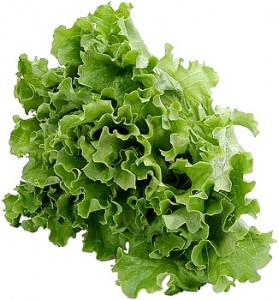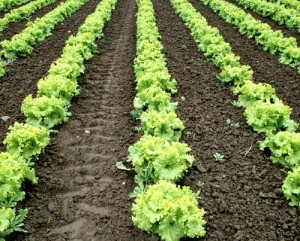 Lettuce (Lactuca sativa) is a temperate annual or biennial plant of the daisy family Asteraceae. It is most often grown as a leaf vegetable. Lettuce was popularly known as lechugas and is native to Southern Europe and Western Asia. In the Philippines lettuce is considered as one of the most important salad crops. Aside from salad, it is used as garnishing for other food preparations.
Lettuce (Lactuca sativa) is a temperate annual or biennial plant of the daisy family Asteraceae. It is most often grown as a leaf vegetable. Lettuce was popularly known as lechugas and is native to Southern Europe and Western Asia. In the Philippines lettuce is considered as one of the most important salad crops. Aside from salad, it is used as garnishing for other food preparations.
Varieties:
1. Loose Leaf Type:
- Red Salad Bowl – Head is Long deeply cut, lobe frilled, color is bronze red, size is very large. Heat tolerant.
- Other varieties includes: Green Salad Bowl
2. Crisp Head/Batavia:
- Blonde de Paris – Leave shape – Tight cap fairly savored, deeply notched borders, color is yellow green, large size. Heat tolerant.
- Other varieties: Great Lakes, Minetto, Armada, Iceberg, Brillantine
3. Butterhead:
- Kagraner Sommer – Leave shape – slightly wavy, medium green color, medium size. Slow bolting, heat tolerant.
- Other varieties: Madrilene, Sucrine, Green Mignonette, etc.
How to grow Lettuce:
Adaptation:
Climatic and Soil Requirements – The loose leaf type thrives well both in the lowlands and highlands. Difference, however, are noticeable in the growth habit. Heading varieties perform best in areas with low temperature. Lettuce does best in sandy loam and silt loam soils rich in organic matter. Where earliness is desired, sandy loam is preferred. If yield is important, silt loam and muck soils are highly preferred. Studies show that lettuce seems to grow better in soil with pH value ranging from 6.0 to 6.8.
Cultural Requirements:
Seedlings are transplanted as soon as they have formed the first true leaves (two to three weeks after sowing) at intervals of 20 to 25 cm. both ways for non-heading varieties and 30 * 30 cm. for the heading varieties. The seedlings are set in two to four rows with a working path of 20 cm between the rows. Planting is recommended during cloudy days or late in the afternoon to avoid excessive wilting of the transplants. Lathering is advisable right after transplanting.
In large scale transplanting, direct seedling can be done depending on the growers desire and on the availability of necessary equipment. In direct seedling, shallow multiple rows, two to four rows, provided with a working path of 50 cm. between multiple rows, are made and the seeds sown very thinly in the furrows and covered thinly with fine soil. Water is sprinkled, particularly when the moisture content of the soil is insufficient for germination. Thin mulch of straw is necessary to enhance germination and to suppress weed growth.
- Cultivation – Cultivation is done when the soil becomes compact. This is to disturb the weeds and to promote soil aeration.
- Irrigation – The greatest amount of root development in lettuce is confide in the top 20 to 25 cm. of soil texture., evaporation losses and rainfall.
- Fertilization – Lettuce plants are poor foragers because of their small root system. In this regard, the soil must be well-supplied with nutrients either from organic or inorganic matter. Preplanting application with 10 tons of stable manure to a hectare, applied during the last field preparation, is recommended. This must be supplemented with about 250 to 300 kg of 12-24-12 fertilizer mixture. Without manure, a hectare may require about 400 kilograms of 12-24-12. Two weeks after planting, side dressing with about 100 kg of ammonium sulfate can be done.
Control of Pests and Diseases:
1. Aphids – These are minute, pale green or black insects, mostly wingless, usually harboring themselves under the surface of the leaves. They cause injury by sucking the plant sap. Heavily infested plants develop abnormal growth, become dwarf and unproductive. Spraying with Malathion or Sevin at the rate of 1 tbs. per gal. of water gives satisfactorily control of the insects.
Diseases and their Control:
1. Mosaic – The disease is caused by a virus. Symptoms on the leaves appear as yellow mottles. Plants become stunted and deformed. Severe infections result in a reduced plant size. Foliage is dull, greenish or yellowish control is by rouging or eliminating weed hosts of the aphids and diseased plants.
2. Bottom Rot – this disease is caused by Rhizoctonia solani Khun, afungus. The disease may be distinguished by the presence of sunken brown spots on the midribs and petioles. In severe cases, the fungus attacks succeeding layers or leaves until the whole plants become slimy. The disease can be controlled through sanitation and crop rotation with non-susceptible crops.

Harvesting:
Approximately lettuce will take about 60 to 70 days from planting to maturity. By then it is ready to harvest. If you want your lettuce to continue to grow for another harvest, just select the outermost leaves. But the quality will not be the same as the first harvest so it’s your choice if you want to start again from the seedling or leave the mature plant for another harvesting. After you gather the your harvest, wash it immediately and pat it dry. Place in plastic bags and store in your refrigerator for selling or just home use.
Source: Cultural Directions for Phil. Agricultural Crops; Photos: foodpoisonjournal.com, chickenmashfarm.com